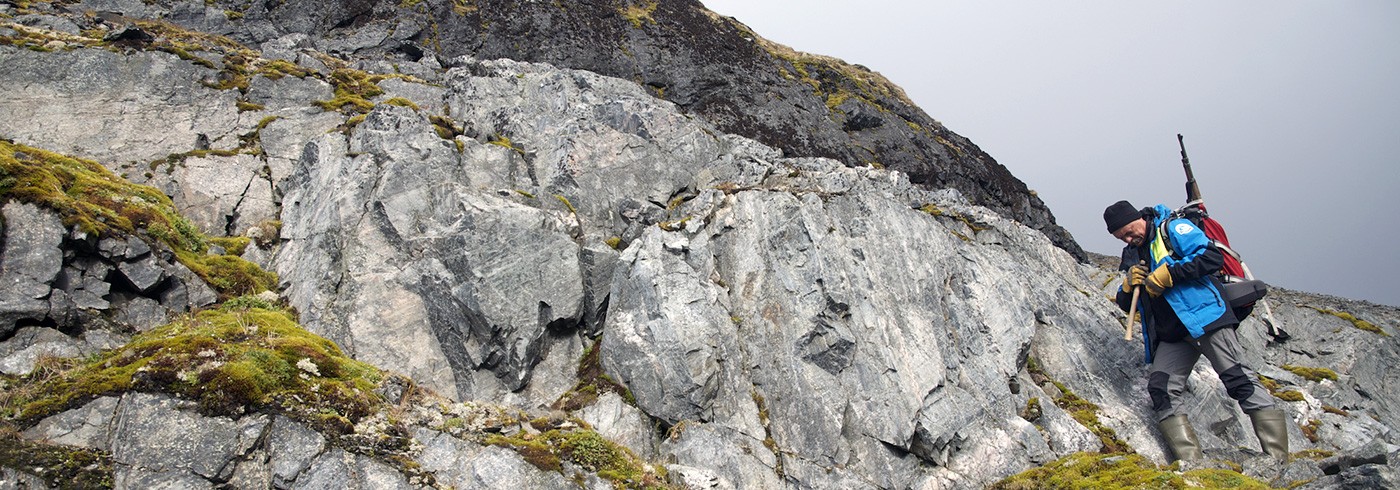Yesterday we got up at 4 am, but getting us and the Zodiac ready took longer than expected. We left the camp at half past five, probably waking up the sailor who had anchored his mighty yacht in the deep water on the other side of Selvågen.
The water in Forlandsundet was rough. A 40 km boat drive in the swell from the persisting northerly winds combined with wind waves brought us to the shore north of Eidembukta in Oscar II Land. We walked along the eastern side of Jørgenfjellet and then crossed Hydrografbreen on the hard ice of the lower reaches of this glacier instead of getting stuck in the muddy moraines in the valleys. Our target was Skipperryggen, a smaller and less well known rock ridge northwest of Motalafjella which, however, exposes the same geological units.
Already in the moraine below the ridge the excitement was close to maximum: deep blue blueschists and eclogites – everything which dramatically increases the pulse of a metamorphic petrologist. Thus, the disappointment was huge when we climbed several hundred metres of the ridge just in ugly marbles… Somebody mentioned that only stupid geologist climb the mountain when the desired outcrops are down in the valley. Well, 30 minutes later we found the first schists with promising high pressure mineralogy. Some tens of metres further on eclogite with a very promising mineral assemblage formed the core of large carbonate boudins in the schist.
Climbing became a bit of a problem in this terrain which mainly can be described as an overhanging pile of scree. But it was worth to continue. First a beautiful schist with garnets the size of golf balls, then, on the next step of the ridge, blueschists and, again, eclogites. Five smiling faces, mission completed… Someone mentioned, that only stupid geologists stay down in the valleys.
Sampling, and then down the steep gravel pit to the glacier – it is really amazing that so many different animals live in this exposed environment on a nunatak. We only have seen a ”rypa” with seven chicks, but on the top of the ridge there are traces (droppings) of hares, foxes and even reindeer. To get back to the Zodiac we decided to try another way. It looked easy on the 1:100000 scale map and we would see something new. What a bad choice…
We walked up to the pass between Svartfjella and Jørgenfjellet, and what we saw on the other side was a steep descent into a valley recently left by a glacier. Down there blocky terrain, up and down and down and up and even more of it for more than two hours (and about two kilometres distance)… Finally an easy walk over the lowlands to the boat, where we arrived two hours later than expected. After 26 km walking plus fieldwork everybody was pretty tired. But there was another 40 km boat ride back to camp. Fortunately, the weather was still fine and conditions better than in the morning. When we entered Selvågen, an immense walrus head emerged from the sea some tens of metres in front of the Zodiac which was going at high speed – a visual experience that can’t be explained by words. The bull decided to dive and we went on at full speed, anxiously looking back. Fortunately, the walrus didn’t become angry! Back at camp about an hour before midnight and we still had to celebrate this successful day.
We didn’t get into our sleeping bags before 2 am. At 8 am the alarm clock woke me up for the weekly call to the Swedish Polar Research Secretariat. The sun shone on the tent – the weather was still fine. Everybody is tired after a day like yesterday, so another hour of sleep in the sunshine, then a bath in the glacial stream near the camp to get clean, and some laundry and cleaning up in the kitchen tent. A late breakfast just when the weather turned bad again. Wind, and rain everywhere around us except at our camp site. But the rain catched us later. We stayed close to the camp, but tomorrow it will be our last day at Selvågen and we want to go southwards to Alasdairhornet, to see some volcanic rocks that are mentioned in one description of the area.
Henning Lorenz, Uppsala universitet










